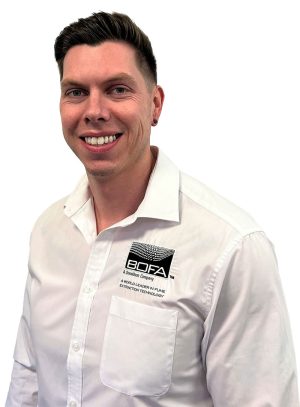Maintaining extraction systems for optimal performance
 Once specified, a BOFA extraction system is designed to be pretty much maintenance-free ‘straight from the box’ when put into service.
Once specified, a BOFA extraction system is designed to be pretty much maintenance-free ‘straight from the box’ when put into service.
However, when your filtration technology is up and running, there are some easy, routine actions worth considering to help keep your system working at optimal performance levels.
- A daily visual inspection will flag up any equipment alerts or alarms that need to be investigated, linked for example to filter saturation levels.
- A weekly supervisor-led inspection should look at the physical condition of extraction devices/nozzles/enclosures/hoses and check the system for damage, changes to configuration and correct operation.
- Once a month, disconnect hoses and check for blockages, signs of dust or vapour/gas/odour carry over (remember to wear appropriate PPE).
- An annual service by a competent engineer is recommended to include these regular checks plus inspection of filter condition, extractor motor and electrics. Replace any filters not exchanged during preceding 12 months.
- Keep a log of actions and findings to help inform future preventative maintenance.
On systems featuring BOFA’s Intelligent Operating System (iQ), sophisticated control software will monitor system performance and filter condition, with an option to download data logs that can be shared remotely with BOFA engineers for expert analysis and rapid response.
BOFA systems typically include a three-stage filtration set-up and not monitoring the rate at which these filters are filling up can have a detrimental effect on extraction performance. For example, if the pre-filter (for larger particles) becomes blocked, this can shorten the lifecycle of the more expensive high-efficiency particulate air (HEPA) filter, while if the activated carbon filter become saturated, gases will bypass this stage, with the potential to return into the working environment.
A tell-tale sign that the extractor needs attention would be when fume and dust is seen to ‘dwell’ within an enclosure rather than clearing through the extraction unit.
In the UK, companies have a legally binding duty to safeguard their employees by complying with HSG258 guidance for controlling airborne contaminants, which includes a 14-month local exhaust ventilation (LEV) recertification process for extraction technology. However, BOFA advises scheduling this for 12-month periods to help avoid any unplanned downtime should an issue arise during the service.

As Tom Bullock, International Sales Manager at BOFA explains: “The guidelines state that a service should be carried out and tested by a competent engineer (British Occupational Hygiene Society P601 certified), such as those employed by BOFA. This process includes a professional assessment, system service and re-certification for compliance.
The precise service process will depend on the configuration and complexity of the system, but generally will include:
- Full initial airflow and pressure measurement at appropriate capture/duct points to ensure compliance with HSG258 guidelines.
- System checks to ensure everything is running to optimal
- A full LEV report detailing the test results and any remedial actions taken in the context of the workplace exposure levels that need to be met.
- Guidance notes and advice on ways filtration performance might be improved.
And remember, for times outside of annual services, BOFA’s technical team is always on hand to provide advice and information to help keep extraction systems in tip-top condition.”


